An Introductory Guide
from the Australian Native Bee Research Centre
The Australian continent has steamy tropical rainforests in the far north, snow capped mountains in the south, and hot dry deserts in the centre. Native bees can be found in most of Australia’s diverse habitats. Multitudes teem through the carpets of flowers in our heathlands and swarm around the blossoms at the tops of gum trees. Some species burrow into the desert sands whilst others nest inside straggly trees near isolated waterholes. Which native bees are found in your area?
| 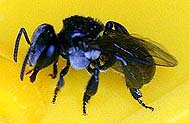 Native bees live in all parts of Australia. This stingless bee (Tetragonula carbonaria) lives in Queensland and NSW. More Photos |
For this introductory guide we have chosen ten major groups of Australian native bees. The states and territories of Australia in which these bees have been found are shown in the following Location Table. Click on the name of each bee in the table to read a brief account of its nest and behaviour.
(More detailed information about these fascinating species can be found in Native Bees of the Sydney Region: A Field Guide and in Aussie Bee bulletin. And visit the Aussie Bee Photo Gallery for more photographs of our colourful native bees!)
(More detailed information about these fascinating species can be found in Native Bees of the Sydney Region: A Field Guide and in Aussie Bee bulletin. And visit the Aussie Bee Photo Gallery for more photographs of our colourful native bees!)
| . |
Qld
|
NSW
|
Vic
|
SA
|
WA
|
NT
|
Tas
|
| Ten Major Groups of Australian Native Bees | . | . | . | . |
.
|
.
| . |
| 1. Stingless Bees | . | . | . | ||||
| 2. Yellow & Black Carpenter Bees | . | . | . | ||||
| 3. Green Carpenter Bees | . | . | . | . | |||
| 4. Reed Bees | |||||||
| 5. Blue Banded Bees | . | ||||||
| 6. Teddy Bear Bees | . | ||||||
| 7. Leafcutter Bees | |||||||
| 8. Resin Bees | |||||||
| 9. Homalictus Bees | |||||||
| 10. Masked Bees | |||||||
Nests and Behaviour of the Ten Major Native Bee Groups
1. Stingless Bees
(Austroplebeia and Tetragonula*)(About ten Australian species)
* Previously called Trigona
Why has their name been changed?
Click here for more photos and videos
Australia’s own native honey bees are tiny (3 - 5 mm), black and stingless! Inside their resinous nest is a queen, drones, and hundreds or even thousands of worker bees. They usually nest inside hollow trees but in northern areas they also nest in urban situations such as inside wall cavities or underneath concrete footpaths.
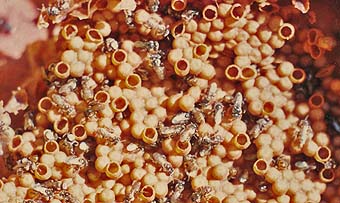 |
Tetragonula hockingsi workers (previously called Trigona hockingsi) on their brood comb
|
The climate of Queensland and the Northern Territory is ideal for stingless bees because they are tropical species. They also thrive in northern NSW (New South Wales) and on the NSW Mid North Coast.
| Stingless bees are mainly found in the northern and eastern areas of Australia |  |
Stingless bees are not found in other areas of NSW, in the ACT (Australian Capital Territory), in Victoria, South Australia or Tasmania. Hives would not survive in these areas without special artificial support.
In Western Australia, stingless bees are only found from the Hamersley Ranges northwards. Local WA authorities strongly oppose the introduction of stingless bees to more southern areas as they may disturb the delicate ecology of the state’s beautiful wildflowers.
Back to Location Table
Do Any Native Bees Sting?
Australia has over 1,500 species of native bees. Only 10 of these species are stingless! These are the native honey-producing bees (Tetragonula - previously called Trigona - and Austroplebeia). All of the other species of native bees in Australia can sting. More details... |
2. Yellow and Black Carpenter Bees
(Xylocopa)(Eight Australian species)Click here for photos
These 15 to 24 mm long bees are the largest native bees in Australia. The females have a glossy black abdomen and bright yellow fur on the thorax. Males are covered uniformly with yellowy brown or olive fur. They are called carpenter bees because they cut nest burrows in soft timber such as the dead limbs of mango trees. These carpenter bees like a warm climate, and in NSW and WA they are restricted to the northern areas. Similar species of carpenter bees in other countries are good pollinators of passionfruit. For more information see Aussie BeeIssue 8.
Back to Location Table
(Xylocopa)(Eight Australian species)Click here for photos
These 15 to 24 mm long bees are the largest native bees in Australia. The females have a glossy black abdomen and bright yellow fur on the thorax. Males are covered uniformly with yellowy brown or olive fur. They are called carpenter bees because they cut nest burrows in soft timber such as the dead limbs of mango trees. These carpenter bees like a warm climate, and in NSW and WA they are restricted to the northern areas. Similar species of carpenter bees in other countries are good pollinators of passionfruit. For more information see Aussie BeeIssue 8.
Back to Location Table
Are There Any Bumble Bees in Australia?
Australia has no native species of bumble bees. Feral European bumble bees (Bombus terrestris) were accidentally introduced to Tasmania in 1992 and now have become widespread throughout that state. However, fortunately they have not reached the Australian mainland yet. |
3. Green Carpenter Bees
(Xylocopa, formerly in genus Lestis)(Two Australian species)Click here for photos
These spectacular bees (up to 17 mm long) are glossy metallic green with tints of yellow or blue. They cut 7 to 10 mm wide nest burrows in the flower stalks of the grass tree (Xanthorrhoea) or in other soft pithy dead timber. Landclearing has caused the loss of these stunning bees from Victoria and mainland areas of South Australia although they can still be found on Kangaroo Island in South Australia. More information can be found in Aussie Bee Issue 3.
Back to Location Table
4. Reed Bees (Exoneura and Braunsapis)(Over 80 Australian species)Click here for photos
Reed bees are slender black bees less than 8 mm long. Some species have a red abdomen. They nest inside dry pithy twigs in plants such as raspberries and blackberries or in the dead fronds of tree ferns. Today many nests can also be found in dead canes of the weed Lantana (more details). Reed bees are featured inAussie Bee Issue 6.
Back to Location Table
5. Blue Banded Bees (Amegilla)(About 25 Australian species)Click here for more photos and video
These bees (mostly 8-13 mm long), with glittering stripes of blue or whitish hair across their black abdomens, are often seen darting around the flowers of lavenders and abelias. The females build nests in shallow burrows in the ground but they may also nest in mudbrick houses or in soft mortar. Each female builds her own nest burrow but many bees often nest together in the one place. Recent research has shown that blue banded bees could be valuable pollinators of greenhouse tomatoes. Blue banded bees are featured in Aussie Bee Issue 2.
Back to Location Table
6. Teddy Bear Bees (Amegilla (Asaropoda))(About 25 Australian species)Click here for photos and video
Most species of these rotund furry brown bees are 7 to 15 mm long. They build shallow nest burrows in soft soil and sometimes nest underneath houses. Each female builds her own nest burrow but many bees may nest together in the one location (see Aussie Bee Issue 7).
In Western Australia there is a very large related species (nearly 20 mm long) called the Dawson’s Burrowing Bee (Amegilla dawsoni). It nests in groups of up to 10,000 in arid clay pans and mud flats (see Aussie Bee Issue 11 and Issue 12).
Back to Location Table
7. Leafcutter Bees (Megachile)(Over 40 Australian species)Click here for photos
Beewatchers often first discover these amazing 6 to 15 mm long bees when they notice rows of neat circular cuts on the edges of some leaves in their garden. Leafcutters use the disks of leaf as a nest building material. They particularly like the soft leaves of roses, Bauhinia and Buddleja. To read about the fascinating nest building behaviour of the leafcutters, see Aussie Bee Issue 9.
Back to Location Table
(Xylocopa, formerly in genus Lestis)(Two Australian species)Click here for photos
These spectacular bees (up to 17 mm long) are glossy metallic green with tints of yellow or blue. They cut 7 to 10 mm wide nest burrows in the flower stalks of the grass tree (Xanthorrhoea) or in other soft pithy dead timber. Landclearing has caused the loss of these stunning bees from Victoria and mainland areas of South Australia although they can still be found on Kangaroo Island in South Australia. More information can be found in Aussie Bee Issue 3.
Back to Location Table
4. Reed Bees (Exoneura and Braunsapis)(Over 80 Australian species)Click here for photos
Reed bees are slender black bees less than 8 mm long. Some species have a red abdomen. They nest inside dry pithy twigs in plants such as raspberries and blackberries or in the dead fronds of tree ferns. Today many nests can also be found in dead canes of the weed Lantana (more details). Reed bees are featured inAussie Bee Issue 6.
Back to Location Table
5. Blue Banded Bees (Amegilla)(About 25 Australian species)Click here for more photos and video
These bees (mostly 8-13 mm long), with glittering stripes of blue or whitish hair across their black abdomens, are often seen darting around the flowers of lavenders and abelias. The females build nests in shallow burrows in the ground but they may also nest in mudbrick houses or in soft mortar. Each female builds her own nest burrow but many bees often nest together in the one place. Recent research has shown that blue banded bees could be valuable pollinators of greenhouse tomatoes. Blue banded bees are featured in Aussie Bee Issue 2.
Back to Location Table
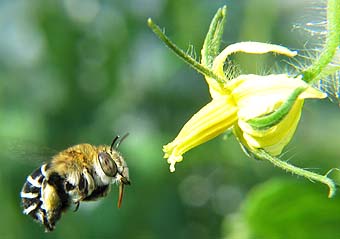 |
A blue banded bee approaching a tomato flower
|
Most species of these rotund furry brown bees are 7 to 15 mm long. They build shallow nest burrows in soft soil and sometimes nest underneath houses. Each female builds her own nest burrow but many bees may nest together in the one location (see Aussie Bee Issue 7).
In Western Australia there is a very large related species (nearly 20 mm long) called the Dawson’s Burrowing Bee (Amegilla dawsoni). It nests in groups of up to 10,000 in arid clay pans and mud flats (see Aussie Bee Issue 11 and Issue 12).
Back to Location Table
7. Leafcutter Bees (Megachile)(Over 40 Australian species)Click here for photos
Beewatchers often first discover these amazing 6 to 15 mm long bees when they notice rows of neat circular cuts on the edges of some leaves in their garden. Leafcutters use the disks of leaf as a nest building material. They particularly like the soft leaves of roses, Bauhinia and Buddleja. To read about the fascinating nest building behaviour of the leafcutters, see Aussie Bee Issue 9.
Back to Location Table
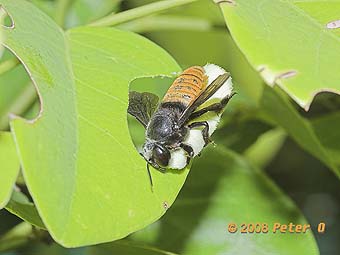 |
A wonderful photograph of a leafcutter bee in action, contributed by Peter O.
|
8. Resin Bees (Megachile, formerly in genusChalicodoma)(About 100 Australian species)
Click here for more photos
Resin bees come in many colours and sizes. For example there are large black 14 mm bees with white tufts of hair, and small 8 mm black bees with bright orange abdomens. They nest in pre-existing holes or gaps in timber or stonework. They are called resin bees because they collect resins and gums to build partitions between their brood cells and to seal their nest holes. Beekeepers sometimes notice resin bees hanging around stingless bee hives, trying to ‘borrow’ a little resin for their nests. Read more about resin bees in Aussie Bee Issue 5.
Back to Location Table
Click here for more photos
Resin bees come in many colours and sizes. For example there are large black 14 mm bees with white tufts of hair, and small 8 mm black bees with bright orange abdomens. They nest in pre-existing holes or gaps in timber or stonework. They are called resin bees because they collect resins and gums to build partitions between their brood cells and to seal their nest holes. Beekeepers sometimes notice resin bees hanging around stingless bee hives, trying to ‘borrow’ a little resin for their nests. Read more about resin bees in Aussie Bee Issue 5.
Back to Location Table
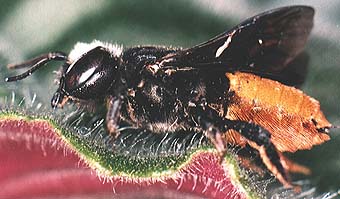 | |
| Resin bees with orange abdomens like to collect resin from stingless bee nests |
9. Homalictus Bees (Homalictus)(44 Australian species)Click here for photo
Although very small (most less than 8 mm long), the glittering Homalictus bees come in a dazzling array of colours. ‘Golden blue’, ‘coppery red’ and ‘green tinged with purple, red or gold’ are just a few of the colours listed by scientists.Homalictus bees dig intricate branching nests in the ground. Many females may live together in each nest, taking turns to guard the narrow nest entrance. One nest was found to be occupied by over 160 females! More details on Homalictusbees can be found in Aussie Bee Issue 17.
Back to Location Table
10. Masked Bees (Amphylaeus, Hylaeus andMeroglossa)(About 200 Australian species)Click here for photos
These slender black bees (most less than 10 mm long) are called ‘masked bees’ because they have pale markings on their faces. Many species also have a distinctive yellow spot on the thorax. Masked bees have very little hair and carry pollen to their nests by swallowing it. The nests are usually in pithy stems or pre existing holes in wood. Masked bees weave their brood cells from an amazing cellophane-like secretion. For more information on masked bees, see Aussie BeeIssue 14).
Back to Location Table
A Final Word to the Australian Bee-Watcher
Australia has over 1,500 species of native bees. During the warmer months you have a good chance of seeing native bees no matter where in Australia you live. We hope you enjoy exploring Australia’s magnificent native bees in your local gardens and bushland!
Although very small (most less than 8 mm long), the glittering Homalictus bees come in a dazzling array of colours. ‘Golden blue’, ‘coppery red’ and ‘green tinged with purple, red or gold’ are just a few of the colours listed by scientists.Homalictus bees dig intricate branching nests in the ground. Many females may live together in each nest, taking turns to guard the narrow nest entrance. One nest was found to be occupied by over 160 females! More details on Homalictusbees can be found in Aussie Bee Issue 17.
Back to Location Table
10. Masked Bees (Amphylaeus, Hylaeus andMeroglossa)(About 200 Australian species)Click here for photos
These slender black bees (most less than 10 mm long) are called ‘masked bees’ because they have pale markings on their faces. Many species also have a distinctive yellow spot on the thorax. Masked bees have very little hair and carry pollen to their nests by swallowing it. The nests are usually in pithy stems or pre existing holes in wood. Masked bees weave their brood cells from an amazing cellophane-like secretion. For more information on masked bees, see Aussie BeeIssue 14).
Back to Location Table
A Final Word to the Australian Bee-Watcher
Australia has over 1,500 species of native bees. During the warmer months you have a good chance of seeing native bees no matter where in Australia you live. We hope you enjoy exploring Australia’s magnificent native bees in your local gardens and bushland!
Like to Know More?
| ||
| Australia’s first and only field guide on native bees,Native Bees of the Sydney Region, provides colour photographs and detailed descriptions of many common Australian native bees. 31 of the most easily-recognised Sydney species are included. Over 20 of these species are also found in Queensland and Victoria. Click here for more details... |
…
| 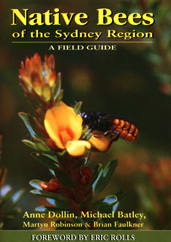 |
Author: Anne Dollin
Tidak ada komentar:
Posting Komentar